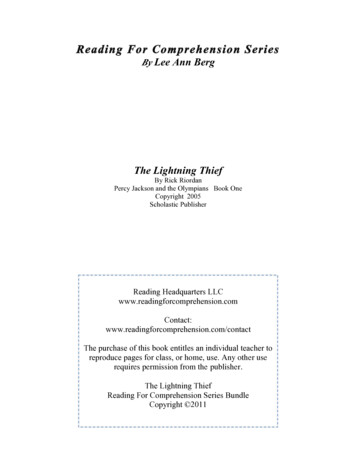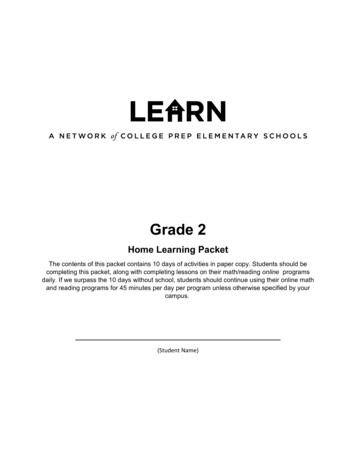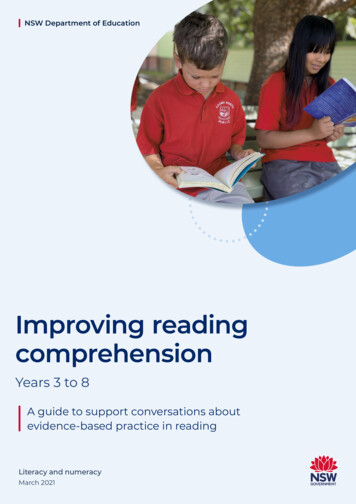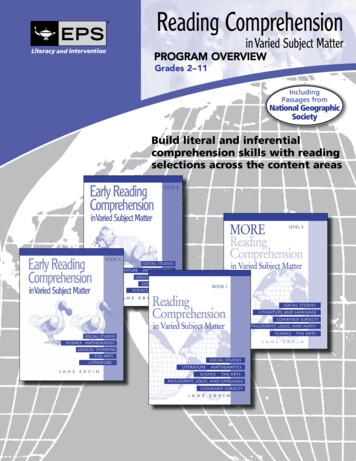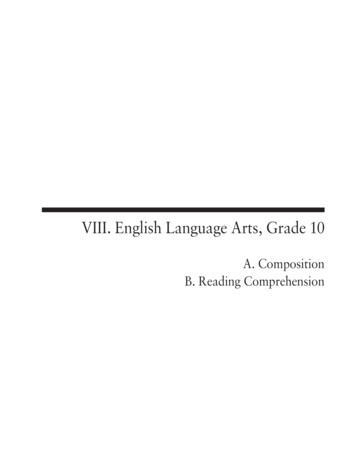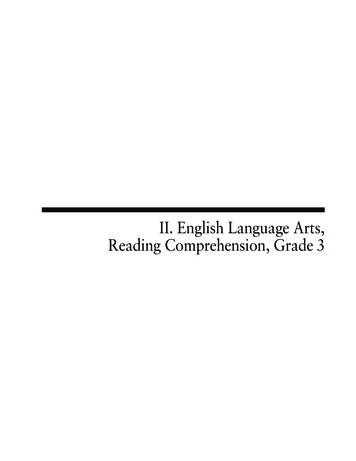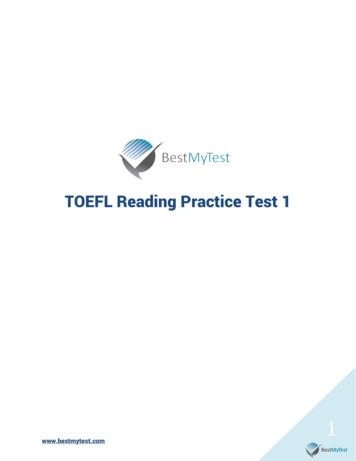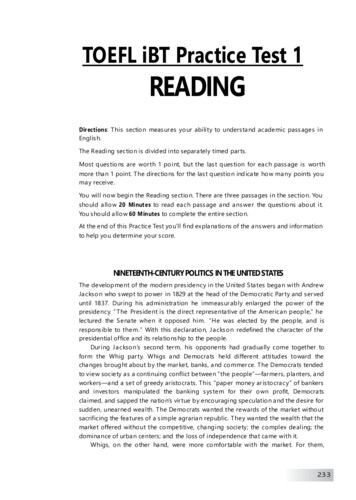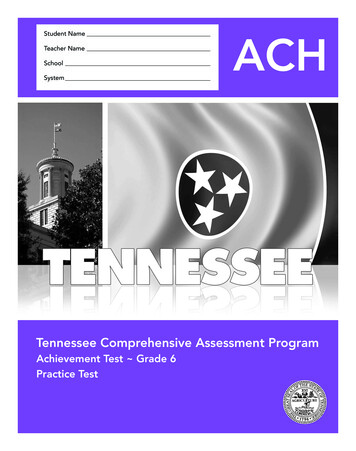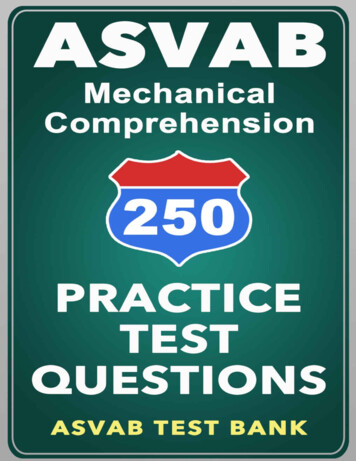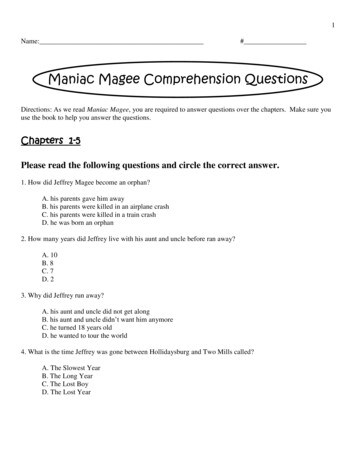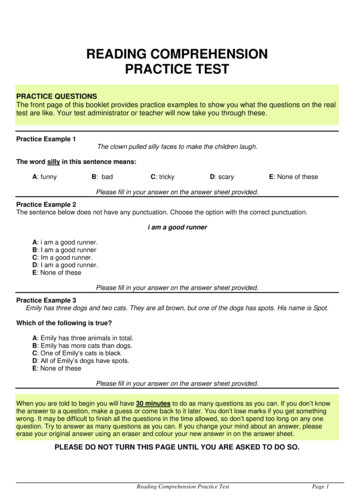
Transcription
READING COMPREHENSIONPRACTICE TESTPRACTICE QUESTIONSThe front page of this booklet provides practice examples to show you what the questions on the realtest are like. Your test administrator or teacher will now take you through these.Practice Example 1The clown pulled silly faces to make the children laugh.The word silly in this sentence means:A: funnyB: badC: trickyD: scaryE: None of thesePlease fill in your answer on the answer sheet provided.Practice Example 2The sentence below does not have any punctuation. Choose the option with the correct punctuation.i am a good runnerA: i am a good runner.B: I am a good runnerC: Im a good runner.D: I am a good runner.E: None of thesePlease fill in your answer on the answer sheet provided.Practice Example 3Emily has three dogs and two cats. They are all brown, but one of the dogs has spots. His name is Spot.Which of the following is true?A: Emily has three animals in total.B: Emily has more cats than dogs.C: One of Emily’s cats is black.D: All of Emily’s dogs have spots.E: None of thesePlease fill in your answer on the answer sheet provided.When you are told to begin you will have 30 minutes to do as many questions as you can. If you don’t knowthe answer to a question, make a guess or come back to it later. You don’t lose marks if you get somethingwrong. It may be difficult to finish all the questions in the time allowed, so don’t spend too long on any onequestion. Try to answer as many questions as you can. If you change your mind about an answer, pleaseerase your original answer using an eraser and colour your new answer in on the answer sheet.PLEASE DO NOT TURN THIS PAGE UNTIL YOU ARE ASKED TO DO SO.Reading Comprehension Practice TestPage 1
Question 1For the little boy, a lolly was tangible, whereas a promise was not.The word tangible in this sentence means:A: basicB: untouchableC: actualD: edibleE: none of theseQuestion 2Please read the following sentence.Once Jane lifted her pen and made a start, writing the essay became easy.If we change the start of the sentence to:Writing the essay became easy.What will the ending be?A: after starting.B: after lifting her pen.C: once Jane lifted her pen and made a start.D: once she lifted her pen and made a start.E: None of these.Question 3A: appallingThe boy’s incorrigible behaviour puzzled his sister.The word incorrigible in this sentence means:B: reformedC: incurableD: frustratedE: none of theseQuestion 4Genealogy is fun. Just as a piece of furniture or a picture takes on much more interestif you know its history, so does an individual become more real once the ancestralelements that shaped him are known. An in-depth family history is a tapestry of allthose to whom we owe our existence.Which statement best conveys the theme of this paragraph?A: Finding out about our ancestors is more interesting than researching the history of objects.B: Genealogy is a study of people and their belongings in the past.C: Genealogy is a study of family history.D: Genealogical research can bring meaning and life to a family’s history.E: Most genealogies are a waste of effort.Question 5Choose the option which will best replace the underlined words in the sentence to make it correct.She done it to quick, so it came out looking rough.A: done it too quickly B: did it too quick C: did it too quickly D: did it to quickly E: none of theseRead the following paragraph to answer the next two questions (Questions 6&7).Tailgating another vehicle is unsafe and illegal. Many rear-end collisions are caused by driversfollowing too close to the vehicle in front of them. The rules state that a driver must keep sufficientdistance from the vehicle in front in order to stop safely and avoid a collision. Drivers should allow aminimum two seconds’ gap between their vehicle and the one ahead. At sixty kilometres an hour, thisequates to thirty-three metres; at a hundred it equates to fifty-five metres. More distance is needed tosafely stop in rain or poor visibility.Question 6Tailgating another vehicle is unsafe because:A: all rear end collisions are caused by drivers following too close to the vehicle in front.B: it may not allow sufficient time and space to stop and avoid a collision.C: it is against the road rules.D: it is a reckless practice.E: None of these.Reading Comprehension Practice TestPage 2
Question 7‘More distance is needed to safely stop in rain or poor visibility.’ We can infer from this that:A: people drive faster in rain and poor visibility.B: the writer is merely calculating on the safe side.C: braking is more hazardous in rain and poor visibility.D: the road rules state that this must be so.E: All of these.Read the following paragraphs to answer the next two questions (Questions 8&9).There is a place forty kilometres north-east of Portland, Victoria, which makes for anunusual visit. It is Lake Condah. Here are to be found remains of aboriginal settlements:the circular stone bases of several hundred huts, rock-lined water channels, and stonetools chipped from rock not normally found in the area. One of the attractions of LakeCondah long ago was its fish and the most startling evidence of aboriginal technology andengineering to be found there are the systems built to trap fish.Water courses had been constructed by redirecting streams, building stone sides andeven scraping out new channels. At strategic spots, they piled rocks across the watercourses to create weirs and build funnels to channel eels and fish into conical baskets.This is an eel-fishing technique which has hardly changed to the present day. Besidesome of the larger traps, there are the outlines of rectangular, stone-lined ponds, probablyto hold fish and keep them fresh.On the bluffs overlooking the lake, stone circles are all that remain of ancient dwellings.Not all of the stones were quarried locally. The huts vary in size, but all have gaps fordoorways located on the lee side, away from the prevailing wind. One theory is that thestone walls were only waist to shoulder high, with the top roofed by branches andpossibly packed with mud.The site presents a picture of a semi-settled people quite different from the stereotype ofnomadic hunter-gatherers of the desert.Question 8The word ‘stereotype’ as used in the above passage means:A: distant culture.B: opposite picture.C: electronic print version.D: standard view.E: None of these.Question 9Lake Condah is seen as unusual, mainly because:A: it is so close to a main town.B: there are remains of buildings still to be seen.C: it reveals a society that was at least partly settled and had building and engineering skills.D: there is evidence that some of the building stone was imported.E: it shows the lake dwellers were totally reliant on fish for a food source.Question 10The sentence below does not have any punctuation. Choose the option with the correctpunctuation.one of these days said mary youll get into troubleA: One of these days, said Mary, you’ll get into trouble.B: “One of these days”, said Mary “you’ll get into trouble”C: “One of these days”, said Mary. “You’ll get into trouble.”D: “One of these days”, said Mary, “you’ll get into trouble.”E: “One of these days”, said Mary, “youll get into trouble.”Reading Comprehension Practice TestPage 3
Question 11What does this sentence suggest?A bird in the hand is worth two in the bush.A: Your own possessions are always worth more to you.B: Birds are hard to catch, so hang on to one if you catch it.C: To have something is better than having nothing at all.D: A trained bird is twice the value of an untrained one.E: There is no point in being envious.Read the following paragraphs to answer the next four questions (Questions 12 - 15).Between us there was, as I have already said somewhere, the bond of the sea. Besidesholding our hearts together through long periods of separation, it had the effect of makingus tolerant of each other's yarns-and even convictions. The Lawyer-the best of oldfellows-had, because of his many years and many virtues, the only cushion on deck, andwas lying on the only rug. The Accountant had brought out already a box of dominoes,and was toying architecturally with the bones. Marlow sat cross-legged right aft, leaningagainst the mizzen-mast. He had sunken cheeks, a yellow complexion, a straight back,an ascetic aspect, and, with his arms dropped, the palms of hands outwards, resembledan idol. The Director, satisfied the anchor had good hold, made his way aft and sat downamongst us. We exchanged a few words lazily.Afterwards there was silence on board the yacht. For some reason or other we did notbegin that game of dominoes. We felt meditative, and fit for nothing but placid staring.The day was ending in a serenity of still and exquisite brilliance. The water shonepacifically; the sky, without a speck, was a benign immensity of unstained light; the verymist on the Essex marshes was like a gauzy and radiant fabric, hung from the woodedrises inland, and draping the low shores in diaphanous folds. Only the gloom to the west,brooding over the upper reaches, became more sombre every minute, as if angered bythe approach of the sun.And at last, in its curved and imperceptible fall, the sun sank low, and from glowing whitechanged to a dull red without rays and without heat, as if about to go out suddenly,stricken to death by the touch of that gloom brooding over a crowd of men.From ‘The Heart of Darkness’, by Joseph Conrad.Question 12The narrator of this passage is telling his story from:A: a wharf.B: the deck of a yacht.C: a high vantage point.D: the edge of the Essex marshes.E: None of the above.Question 13The mood of the men in this passage is best described as:A: surly.B: resigned.C: contemplative. D: restless.E: ecstatic.Question 14From the passage, it is clear that the men:A: do not get along.B: show a quiet understanding.C: cannot be bothered with one another.D: have just had a quarrel.E: are worn out.Question 15The word ‘diaphanous’, used to describe the mist, means:A: almost transparent. B: fragile.C: suffocating.D: silentReading Comprehension Practice TestE: none of the above.Page 4
Read the following paragraphs to answer the next four questions (Questions 16 - 19).Among predatory dinosaurs, few flesh-eaters were bigger, faster and nastier than the"tyrant lizard" of popular imagination, the Tyrannosaurus Rex. At least, that is what wehave been led to believe.Now research suggests that, far from being the Ferrari of dinosaurs, Tyrannosaurus Rex,whose ferocious reputation has fascinated generations of schoolchildren, was in fact acumbersome creature with a usual running speed of twenty-five kilometres an hour. Thisis a mere snail's pace compared with modern animals such as the cheetah.Unlike some of the predators of today's African savannah, which can change directionalmost immediately, the dinosaur would have had to turn slowly or risk tumbling over. Andwhile a human can spin forty-five degrees in a twentieth of a second, a Tyrannosauruswould have taken as much as two seconds, as it would have been hampered by its longtail. Thankfully, however, all its prey, such as triceratops, would have been afflicted withthe same lack of speed and agility.The findings were reached after researchers used computer modelling and biomechanicalcalculations to work out the dinosaur's speed, agility and weight. They based theircalculations on measurements taken from a fossil dinosaur representative of an averageTyrannosaurus and concluded the creatures probably weighed between six and eighttonnes.Calculations of the leg muscles suggest that the animal would have had a top speed offorty kilometres an hour, which is nothing compared to a cheetah’s one hundredkilometres an hour. It is sobering to reflect, though, that an Olympic sprinter runs at aboutthirty-five kilometres an hour, not sufficient to outrun a Tyrannosaurus, should Man havebeen around at that time!Question 16Being known as the ‘Ferrari of dinosaurs’ means Tyrannosaurus Rex:A: wore shoes.B: was a quick and agile creature.C: was a hunting machine.D: was the most ferocious of dinosaurs.E: None of these.Question 17In turning, a Tyrannosaurus would have been hampered by:A: its weight.B: its bulky leg muscles.C: its overall size.D: its tail length.E: All of the above.Question 18In calculating the size, speed and agility of Tyrannosaurus Rex, scientists used:A: examination of fossils.B: biomechanical calculations and computer models.C: comparisons with modern animals.D: A and B together.E: B and C together.Question 19The overall theme of the passage is:A: Because it was cumbersome, Tyrannosaurus Rex was lucky to survive.B: Tyrannosaurus Rex’s speed and agility were still superior to those of other dinosaurs.C: Tyrannosaurus Rex’s fierce reputation is now laid to rest.D: Compared to modern predatory animals, Tyrannosaurus Rex was slow and cumbersome.E: None of these.Reading Comprehension Practice TestPage 5
Read the following paragraph to answer the next four questions (Questions 20 - 23)."Anne," cried Mary, still at her window, "there is Mrs Clay, I am sure, standing under thecolonnade, and a gentleman with her. I saw them turn the corner from Bath Street justnow. They seemed deep in talk. Who is it? Come, and tell me. Good heavens! I recollect.It is Mr Elliot himself.""No," cried Anne, quickly, "it cannot be Mr Elliot, I assure you. He was to leave Bath atnine this morning, and does not come back till to-morrow."As she spoke, she felt that Captain Wentworth was looking at her, the consciousness ofwhich vexed and embarrassed her, and made her regret that she had said so much,simple as it was.Mary, resenting that she should be supposed not to know her own cousin, began talkingvery warmly about the family features, and protesting still more positively that it was MrElliot, calling again upon Anne to come and look for herself, but Anne did not mean to stir,and tried to be cool and unconcerned. Her distress returned, however, on perceivings
begin that game of dominoes. We felt meditative, and fit for nothing but placid staring. The day was ending in a serenity of still and exquisite brilliance. The water shone pacifically; the sky, without a speck, was a benign immensity of unstained light; the very mist on the Essex marshes was like a gauzy and radiant fabric, hung from the wooded rises inland, and draping the low shores in .
